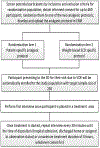Trial design of comparing patient-specific versus weight-based protocols to treat vaso-occlusive episodes in sickle cell disease (COMPARE-VOE)
- PMID: 33348066
- PMCID: PMC7954959
- DOI: 10.1016/j.cct.2020.106252
Trial design of comparing patient-specific versus weight-based protocols to treat vaso-occlusive episodes in sickle cell disease (COMPARE-VOE)
Abstract
Objectives: Painful vaso-occlusive episodes (VOE) are the most common reason for emergency department (ED) visits experienced by patients with sickle cell disease (SCD). The National Heart, Lung and Blood Institute (NHLBI) evidence-based recommendations for VOE treatment are based primarily on expert opinion. In this randomized controlled trial (RCT), we will compare changes in pain scores between patients randomized to a patient-specific analgesic protocol versus those randomized to a weight-based analgesic protocol, as recommended by the NHLBI guidelines.
Methods: We report the rationale and design of a multi-site, phase III, single-blinded, RCT to be conducted in six EDs in the United States. Eligible participants will be randomized after providing consent, anticipating 50% of those randomized would have an ED visit during the enrollment period. A total of 230 participants with one VOE ED visit provides sufficient power to detect a clinically significant difference in pain score reductions of 14 between groups with 0.05 type I error. Uniquely, this trial randomizes participants in a larger population than the study population, given the impossibility of consenting and randomizing participants during emergencies. The primary endpoint is the change in pain scores in the ED from time of placement in treatment area to time of disposition (hospitalization, discharged home, or assigned to observation status) or a maximum treatment duration of 6 hours. Additional outcomes include hospitalizations and ED visits seven days post enrollment, side effects, and safety assessments.
Conclusions: The COMPARE-VOE study design will provide high-level evidence to support the NHLBI VOE treatment guidelines.
Keywords: Clinical trial; Emergency department; Pain management protocol; Sickle cell disease; Vaso-occlusive crisis; Vaso-occlusive episode.
Copyright © 2020 Elsevier Inc. All rights reserved.
Conflict of interest statement
CONFLICT OF INTEREST STATEMENT
Stephanie Ibemere has received postdoctoral fellowship salary support from the NHLBI.
Sarah Dubbs declares no conflict of interest.
Huiman Barnhart declares no conflict of interest
Jacqueline Brown declares no conflict of interest.
Caroline Freiermuth has received a quality improvement grant from Pfizer, administered by the American College of Emergency Physicians. In addition, she was a site investigator and received research funds from Pfizer for the Phase 3 trial on safety and efficacy on Rivipansal. All research funds were distributed to the University of Cincinnati and not directly to the investigator.
Patricia Kavanagh declares no conflicts of interest.
Judith Paice declares no conflicts of interest.
John Strouse has received research support through his institution from Takedea Pharmaceutical Company Limited.
R. Gentry Wilkerson has received a grant from Pfizer and the American College of Emergency Physicians and has received research support from Pfizer and Prolong Pharmaceuticals.
Paula Tanabe declares no conflict of interest.
Similar articles
-
A randomized controlled trial comparing two vaso-occlusive episode (VOE) protocols in sickle cell disease (SCD).Am J Hematol. 2018 Feb;93(2):159-168. doi: 10.1002/ajh.24948. Epub 2017 Nov 10. Am J Hematol. 2018. PMID: 29047145 Free PMC article. Clinical Trial.
-
Sickle Cell Disease Treatment with Arginine Therapy (STArT): study protocol for a phase 3 randomized controlled trial.Trials. 2023 Aug 17;24(1):538. doi: 10.1186/s13063-023-07538-z. Trials. 2023. PMID: 37587492 Free PMC article.
-
Trends and hospital practice variation for analgesia for children with sickle cell disease with vaso-occlusive pain episodes: An 11-year analysis.Am J Emerg Med. 2024 Dec;86:129-134. doi: 10.1016/j.ajem.2024.10.028. Epub 2024 Oct 13. Am J Emerg Med. 2024. PMID: 39427500
-
Impact of Different Definitions of Vaso-Occlusion on Efficacy Assessments in Sickle Cell Disease Clinical Trials.Adv Ther. 2025 May;42(5):2490-2499. doi: 10.1007/s12325-025-03162-2. Epub 2025 Mar 27. Adv Ther. 2025. PMID: 40146367 Free PMC article. Review.
-
Pain management in children with sickle cell disease.Paediatr Drugs. 2003;5(4):229-41. doi: 10.2165/00128072-200305040-00003. Paediatr Drugs. 2003. PMID: 12662119 Review.
Cited by
-
A comparison of the effect of patient-specific versus weight-based protocols to treat vaso-occlusive episodes in the emergency department.Acad Emerg Med. 2023 Dec;30(12):1210-1222. doi: 10.1111/acem.14805. Epub 2023 Nov 12. Acad Emerg Med. 2023. PMID: 37731093 Free PMC article.
-
Comparison of Measures of Pain Intensity During Sickle Cell Disease Vaso-Occlusive Episodes.J Pain. 2024 Dec;25(12):104658. doi: 10.1016/j.jpain.2024.104658. Epub 2024 Aug 21. J Pain. 2024. PMID: 39154808 Clinical Trial.
-
Development of a Calculator to Determine Individualized Opioid Doses for Treatment of Vaso-Occlusive Episodes for Sickle Cell Disease in the Emergency Department.Jt Comm J Qual Patient Saf. 2025 Jan;51(1):74-79. doi: 10.1016/j.jcjq.2024.10.002. Epub 2024 Oct 17. Jt Comm J Qual Patient Saf. 2025. PMID: 39581832
-
Impact of Individualized Versus Weight-Based Pain Protocols on Patient Satisfaction for Patients With Sickle Cell Disease Experiencing a Vaso-Occlusive Episode.J Emerg Nurs. 2025 Jul;51(4):626-635. doi: 10.1016/j.jen.2024.12.014. Epub 2025 Feb 27. J Emerg Nurs. 2025. PMID: 40019423 Clinical Trial.
References
-
- Jiang HJ, Barrett ML, Sheng M. Characteristics of Hospital Stays for Nonelderly Medicaid Super-Utilizers, 2012: Statistical Brief #184. In: Healthcare Cost and Utilization Project (HCUP) Statistical Briefs. Agency for Healthcare Research and Quality (US); 2006. Accessed April 26, 2020. http://www.ncbi.nlm.nih.gov/books/NBK269028/ - PubMed
-
- Benjamin L, Dampier C, Jacox A, Odesina V, Phoenix D, Shapiro B. Guideline for the Mangement of Acute and Chronic Pain in Sickle-Cell Disease. Glenview IL Am Pain Soc. 1999;(1).
-
- National Heart, Lung, and Blood Institute. Evidence-Based Management of Sickle Cell Disease: Expert Panel, 2014. Dep Health Hum Serv Natl Inst Health Natl Heart Lung Blood Inst. Published online 2014:161.
Publication types
MeSH terms
Substances
Grants and funding
LinkOut - more resources
Full Text Sources
Other Literature Sources
Medical


